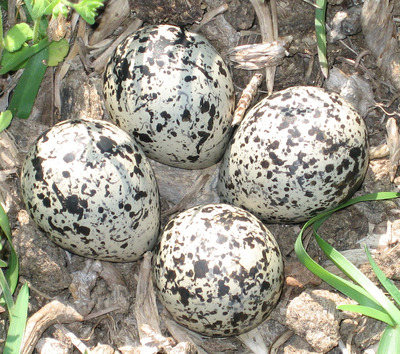 Most Rye residents probably have never heard of killdeer, which are shore birds in the plover family.
Most Rye residents probably have never heard of killdeer, which are shore birds in the plover family.
By Bill Lawyer
 Most Rye residents probably have never heard of killdeer, which are shore birds in the plover family. Plovers are a group of wading birds belonging to the subfamily Charadriinae, of which there are 40 species. The closely related lapwing subfamily, Vanellinae, comprises another 20-odd species.
Most Rye residents probably have never heard of killdeer, which are shore birds in the plover family. Plovers are a group of wading birds belonging to the subfamily Charadriinae, of which there are 40 species. The closely related lapwing subfamily, Vanellinae, comprises another 20-odd species.
Plovers are found throughout the world.
Characterized by relatively short bills, they hunt by sight, rather than by feel, as longer-billed waders such as snipes do. They feed mainly on insects, worms and other invertebrates, depending on habitat. Plover use a run-and-pause technique for getting their food, rather than the steady probing of other wader groups.
What makes killdeer special is their somewhat suicidal penchant for establishing their nests directly out in the open, on the ground — in parking lots, fields, and even residential lawns. While they are considered shore birds, their nests are often located far from shore.
And yet, after the seemingly irresponsible killdeer more or less “ask for” having their nests raided by predators of all types, they come up with a unique means of protecting their eggs or hatchlings – the broken wing defense. This involves the nesting parent leaving its nest when a predator approaches, and flapping its wing or wings frantically, as if it cannot fly. This then diverts the predator from the nest to the adult bird, who keeps leading the predator away until it gives up.
To see a video of this in action, visit www.youtube.com/watch?v=5nmzi_mlFXQ.
Nature provides some defensive help, too. Killdeer eggs are speckled white and brown, and they can easily be mistaken for rocks.
 The killdeer and their unusual nesting/defense habits became the subject of great concern recently on the part of a group of neighbors of Rye Town Park. In late April, two particular neighbors, who wish to remain anonymous, noticed what they later learned was a killdeer, sitting on a nest in the woodchips surrounding a tree stump – right in the southwest section of the park.
The killdeer and their unusual nesting/defense habits became the subject of great concern recently on the part of a group of neighbors of Rye Town Park. In late April, two particular neighbors, who wish to remain anonymous, noticed what they later learned was a killdeer, sitting on a nest in the woodchips surrounding a tree stump – right in the southwest section of the park.
After determining what these birds were (for there were both a male and a female), and that they indeed had four eggs in the nest, the concerned neighbors contacted the park staff, wondering what they should do to protect the nest from natural predators and, as they put it, “out of control dogs.”
Research by Rye Town Park staff revealed that a similar situation had occurred at Grass Island in Greenwich last spring. Grass Island has not been a real island since the early 20th century. Located off Shore Road near the Greenwich train station, the peninsula has a 14-acre nature preserve. Next to it is the heavily visited Greenwich Boat and Yacht Club. Most logical animals would put their nest in the nature preserve, but not these birds. They put it in the club’s gravel parking lot!
From the experiences of protecting the birds at Greenwich, the Rye neighbors determined that they should cordon off an area at the point where the parent birds would start their “wounded wing” behavior. They used poles and snow fencing to make a rectangular protected area.
While the enclosure was being erected, the parents moved away and went through their histrionics. Once it was completed, the volunteers watched from a distance to see what would happen. One of the parents moved up to the enclosure and back, numerous times, but it made no attempt to fly over the snow fencing and return to the nest.
The volunteers decided to cut out some of the fencing near the ground, so that the parents could get to the nest without having to fly. Figuring out the behavior of wild birds and their reaction to snow fencing is far from an exact science.
And snow fencing won’t stop a really hungry raccoon or a persistent pooch. There’s only so much you can do.
When a member of the Rye Town Park staff checked the nest the next morning, however, sure enough, the mother was on the nest – looking very relaxed.
As of this writing, things are still going along fine.















